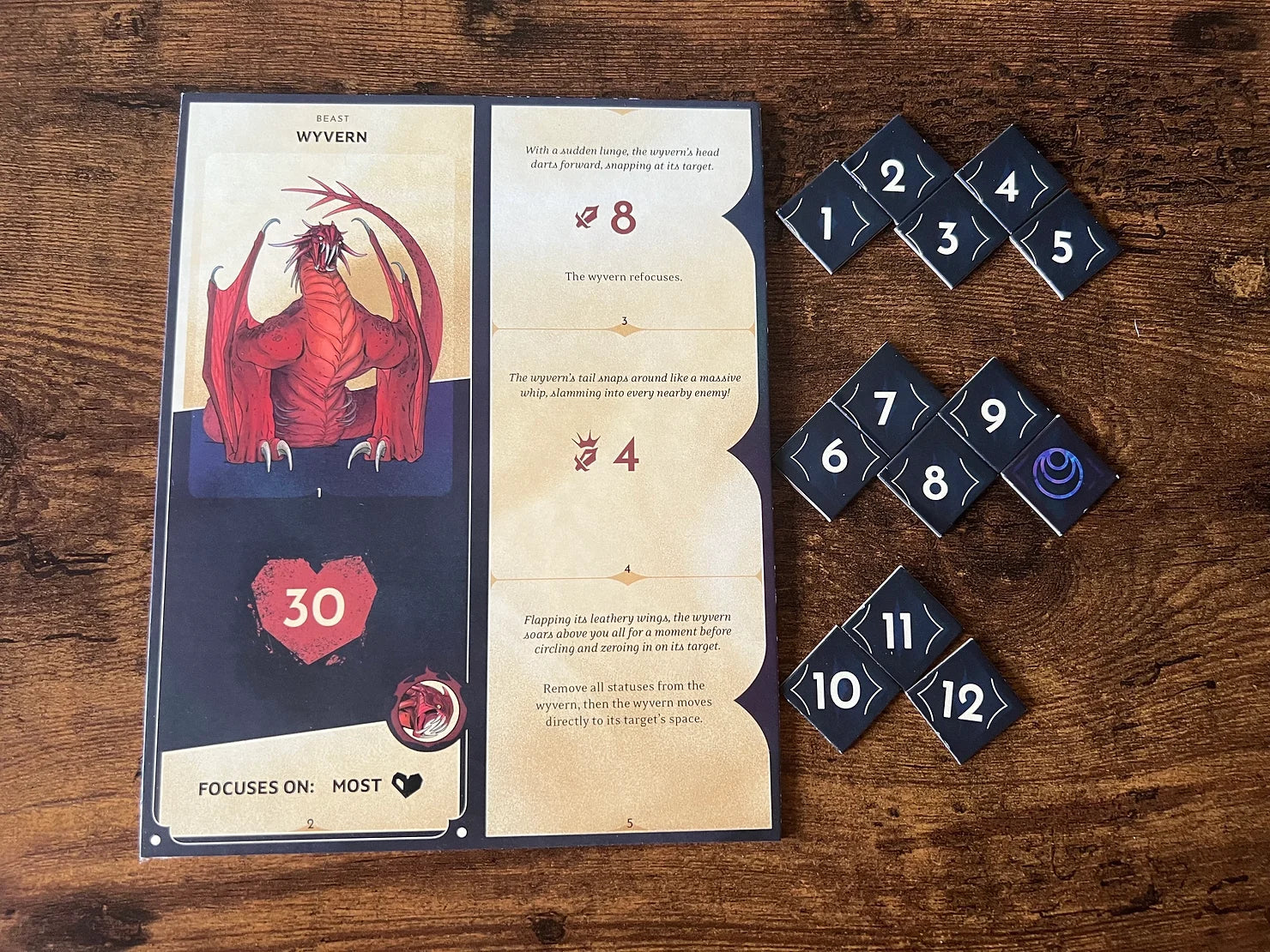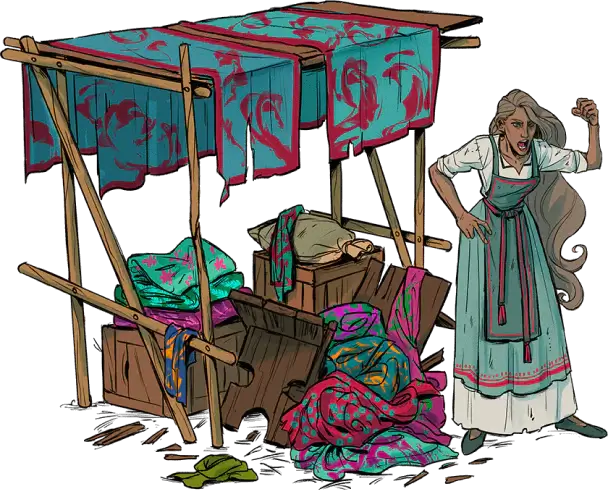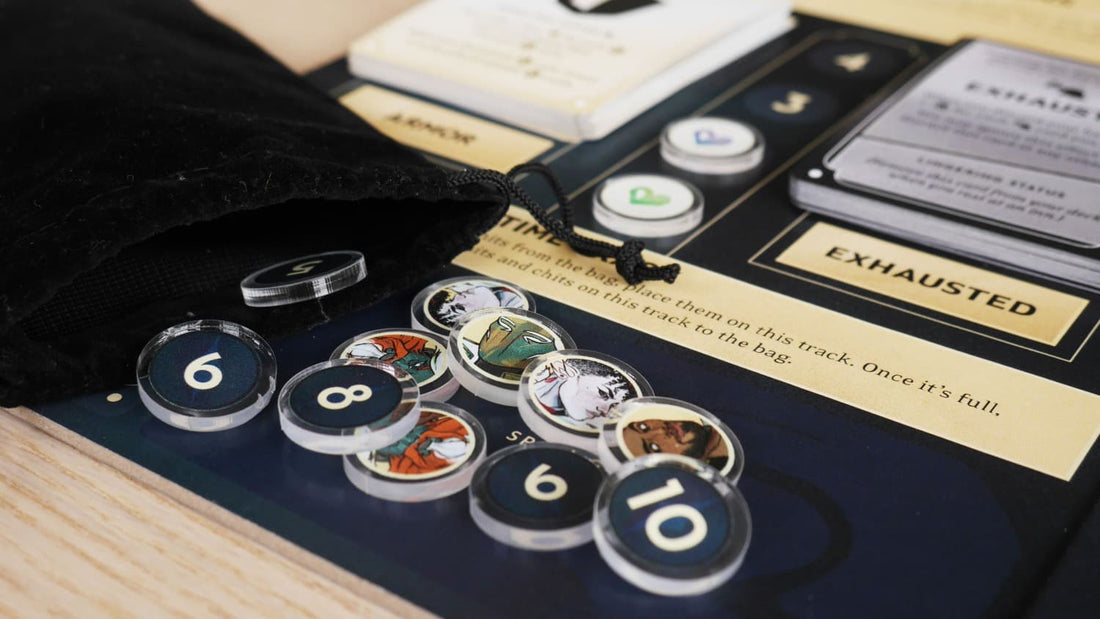Kinfire Chronicles: Night's Fall designer Kevin Wilson (Arkham Horror, Descent) discusses the unique turn mechanic of the Destiny bag during battles in the game

One of the most important design decisions I made on Kinfire Chronicles: Night’s Fall was the inclusion of the destiny bag. In the bag are plastic chits that determine who gets the next turn. Each battle, the bag starts with 12 seeker chits that represent the various heroes being played by the players, and 12 enemy chits numbered 1 through 12. When a seeker’s chit is drawn from the bag, that player gets a turn, and when an enemy’s chit is drawn from the bag, that enemy gets a turn. As you go along, there are fewer and fewer chits left in the bag, so it’s more like drawing from a deck of cards than rolling dice (but with way less shuffling). At its core, this is a very basic mechanic, but it has a lot of implications for gameplay, and there are a few other details I’m intentionally leaving out for the moment.
So, why would I want to use a system like this instead of just going around the table and taking turns like most games? There’s actually several very good reasons:
First, it creates drama. You know your chits are in the bag, but you don’t know when they’re coming out. Sometimes the seekers will feel like they’re unstoppable, other times the enemies will go on a terrifying rampage that has the players sweating. Drama is something that I prioritize in my designs, because even if you sometimes get some unfair-feeling situations, you also create some very memorable moments.
Second, it keeps players engaged. There’s never a moment when you know that four other players have to take their turn before it will come back around to you. It’s always _possibly_ your turn next. This helps keep players focused and participating in the game, which in turn keeps it moving along.
Third, it creates a really simple structure for players to learn. Each battle has a little bit of setup, then you start drawing chits, and the chits tell you what to do for the rest of the battle. Nice and easy to remember.
And finally, the destiny bag ties into the enemy AI and determines what they do. You see, there’s a set of tokens numbered 1 through 12 that are placed next to the enemies’ character sheets at the start of each battle. When the #3 chit is drawn from the bag, the action next to the #3 token triggers. This could cause a wyvern to move to a seeker and bite them, or it might cause a cultist to heal their companions. This creates an incredibly flexible set of enemy behaviors that help to make every combat feel unique and interesting. Actions can be weighted to create more predictable behaviors, or the tokens can be evenly spread out for less predictable patterns. Enemy behaviors can even be modified on the fly during the battle with very little effort, which is an incredibly powerful toolset to work with.

When you pull chit #3 out of the bag the Wyvern will perform its top attack
But what about chit counting? When you get towards the bottom of the bag, won’t you know what chits are left, spoiling any drama? True, so I added a “time track”. There are 5 special chits in the bag that are placed on a time track next to the board after being drawn. Once 4 of them have been drawn and placed on the track, all chits are returned to the bag, so you will generally see most of, but never all of the chits in the bag before it resets.
Of course, if we have 5 special chits that need to go in the bag anyway, why not do something interesting with them and smooth out some of the quirks of the bag at the same time? So, I decided to make 3 of the special chits into hearts. When a heart is drawn, the players as a group get to choose any seeker, and that seeker gets a turn. A wild hero chit, if you will. If a player’s chits are being stubborn about coming out of the bag, you can always throw them a heart turn. The other 2 chits I made into Darkness chits, for the enemies. They work like normal enemy chits except that A) the Darkness token tends to be assigned to the most dangerous action a group of enemies has, and B) they go on the time track after being drawn. So, they’re bad news, but not particularly complicated.
This all still might feel pretty random to some, so there are of course ways for the players to control the destiny bag. Some of the cards in their decks are chit redraws. If a chit is drawn that you don’t want to see trigger right then, play a chit redraw to return it to the bag and draw again. There’s no guarantee that you won’t redraw the same chit again, of course, but that helps to maintain the level of drama.
The other way the players can control the destiny bag is through fate tokens. Before you draw a chit from the bag, the players can choose to spend one of their limited fate tokens to draw 3 extra chits. They then choose which 1 of the 4 chits to resolve, returning the other 3 to the bag. Now, whenever you spend a fate token, there’s a little box in the game called the Void with a piggy bank slot in the lid, and you drop the fate token into the Void through the slot, never to be seen again.

You can spend this Fate token to give yourself an advantage in battle, but you'll lose it to the Void
So, hopefully, reading about the destiny bag and the decisions that went into it have started to give you a feel for the game and whether or not it’s something you might enjoy. Next time I’ll actually talk about what specifically happens during a player’s turn, including an explanation of action and boost cards.



